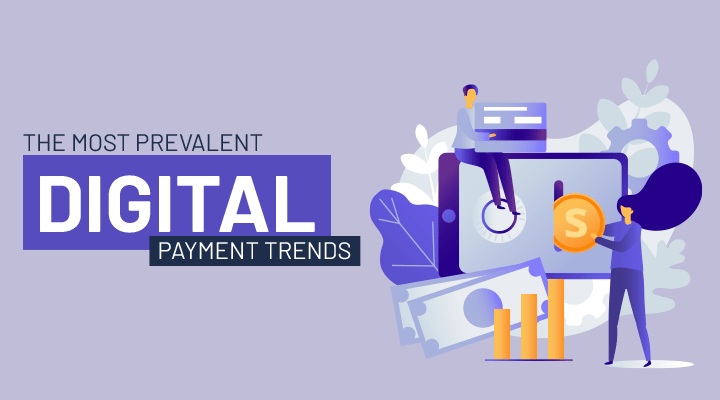Suppose that, you are a little kid out with your dad to a local market. You constantly nudge him to get you a toy that you saw in a shop. He takes you there but unfortunately the shopkeeper doesn’t have the change to give back in cash. So, your dad decides to either ditch the idea of buying or go around other shops for change hunting.
The process seems much of an ordeal today. Doesn’t it?
This is because we are accustomed to making transactions just by a tap!
Even the idea of going to a shop seems weary. Well, why should I physically go to a store when Hamleys deliver online!
This is how technology has transformed our lives, shopping habits and the way we make payments.
Digital payment has swiftly replaced traditional financial services by providing convenience and security to both consumers and business owners.
At present, digital payments received a major push by the coronavirus pandemic. With consumers beginning to avoid cash transactions to lessen physical interaction, online payment is becoming a new norm. According to Statista Data, so far in 2020, a staggering $4.4 million worth of transactions have been through digital payment methods.
This suggests that there are endless opportunities for e-businesses. Here are global digital trends to watch out for.
- Tech-Savvy Generation Z
Who is Generation Z? The term Generation Z applies to individuals born after 1995. These digital natives are highly dependent on automated and swift services and technologies. From paying the house-help to paying for food through apps, this generation has given up on cash. Generation Z consumers are changing the payments landscape. They are the driving factors of on-the-go mobile shopping and payment platforms like Venmo, PayPal, Zelle, etc.
Accenture survey that found 68% of Gen Z consumers are interested in instant P2P payments more than any other age group. To keep up with the demands of this digital-first generation, businesses will need to become fully digital and innovate their payment methods.
2. Biometric Authentication
The problems of security breach, identity theft and fraud are on a rise. Mitigating these risks is crucial and one solution is Biometric Authentication. Biometric authentication is a kind of a verification method which involves biological characteristics of a person. This includes facial recognition, iris recognition, heartbeat scanning, fingerprint scanning, etc. This is necessary to provide accuracy, security and build customer loyalty.
Hence, companies are deploying biometric solutions as a form of authentication. For instance, Apple by using fingerprinting in Apple TouchID to make mobile POS payments via smartphones much more secure. This verifies a user’s identity and simplifies the payment process. Banks like American Express, ING Bank, OutBank DE and Deutsche Bank have included Touch ID in their mobile banking apps. Therefore, one can say that biometrics is rising especially with the rise of customized solutions. According to the industry data, by the year 2021, there will be more than 18 billion biometric transactions taking place every year.
3. Voice-enabled Payment
AI-powered voice control is not only about- ‘Alexa, play Ed Sheeran’ or ‘Siri, set the timer for five minutes’. It is an emerging trend in eCommerce mobile payments. Considering the popularity of voice assistants, financial institutions and stores are either working with Amazon or Google or offering their voice assistants. You can place an order at Starbuck using Alexa. Apple Pay Cash platform enables users to make payments with voice through platforms like Venmo, PayPal. Banks like Capital One, American Express have already tied up with either Alexa, Siri, or Google assistant.
According to Statista, 28% of people use smart speakers for sending money or making direct payments. Voice payment systems have few drawbacks like loopholes in privacy and security. However, with the advancement in technology and demand by users, voice payments might increase in the future.
4. Fraud Prevention Powered by AI and Machine Learning
Security is a major concern when it comes to digital payments. Customers prefer safe transaction methods. And that is why every industry is fighting to protect the payment ecosystem from potential cyber threats. AI and machine learning are becoming valuable tools to secure eCommerce transactions. Let’s find out how this works.
Every transaction includes important customer data. With the help of machine learning and AI, companies can analyze data and identify fraudulent activities. Banks use machine learning software to detect fraud transactions. Every time you make a transaction, you receive a text asking if you carried out the activity. Such messages help you and the bank prevent fraud activities. AI can help detect fraud by spotting fraudulent activities. This makes payment experience convenient and most importantly secure.
5. Mobile Point of Sale (mPOS) Technology
Mobile Point of Sale (mPOS) is a smartphone, tablet or any wireless device that works as a cash register or electronic point-of-sale terminal (POS terminal) wirelessly. mPOS is ideal for businesses such as food trucks, trade shows, and flea markets that are mobile.
It offers multiple payment options thus increasing customer experience. Because this system doesn’t require any payment register or software, it is a cost-effective option for small business owners. A major advantage of this method is increased data security. mPOS device supports encrypted transactions and therefore doesn’t store card details. According to Business Insider, there will be around 27.7 million mPOS devices operational by the year 2021. This shows that mPOS is going to remain in trend for the coming years.
6. NFC (near-field communication) Mobile Payments
You can carry out a contactless transaction just by a tap of a swipe. We will see a rise in contactless payment methods as they are faster and secure. NFC technology powers contactless payments via Apple Pay, Android Pay, and contactless cards. Near Field Communication is a technology that allows two NFC-enabled devices to share data when in close- proximity. It works on the clutter-free method of Tap and Go. Consumers can easily carry out transactions when they tap their NFC-enabled card/device on NFC payment acceptance device.
Many countries use this technology. For example, in London, this type of payment is popular for bus transport. According to a report by UK Finance, by 2027, NFC enabled contactless cards will account 36% of all payments.
Are You ready?
Digital payments are the future and serve as an important factor in customer engagement. If you are still caught up in conventional ways of transactions, it’s time to jump ahead and upgrade to new tech!
Author Bio:
Maulik Shah is the Founder and CEO of Biztech IT Consulting and Solutions, a fast-growing IT solutions provider specializing in eCommerce website design and eCommerce solutions. Maulik is a tech enthusiast and writes about the various aspects of eCommerce web development.








